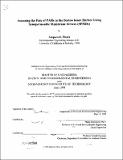| dc.contributor.advisor | Philip Gschwend. | en_US |
| dc.contributor.author | Flores, Amparo E. (Amparo Espino), 1975- | en_US |
| dc.date.accessioned | 2009-06-30T18:24:42Z | |
| dc.date.available | 2009-06-30T18:24:42Z | |
| dc.date.copyright | 1998 | en_US |
| dc.date.issued | 1998 | en_US |
| dc.identifier.uri | http://hdl.handle.net/1721.1/46242 | |
| dc.description | Thesis (M.Eng.)--Massachusetts Institute of Technology, Dept. of Civil and Environmental Engineering, 1998. | en_US |
| dc.description | Includes bibliographical references (leaves 81-87). | en_US |
| dc.description.abstract | This study used a relatively new sampling tool called semipermeable membrane devices (SPMDs) to quantify dissolved concentrations of the following polycyclic aromatic hydrocarbons (PAHs) in three locations of the Boston Inner Harbor: phenanthrene, methylphenanthrene's, fluoranthene, pyrene, benz(a)anthracene, and chrysene. The field measurements ranged from 0.61 to 90 ng/L for the various PAHs at the base of Tobin Bridge, the mouth of Chelsea River, and near the Logan Airport. A vertical gradient in PAH concentrations was observed at the base of Tobin Bridge, revealing a concentration ten times greater in the upper layer (4 m from the surface) than the lower layer (8 m from the surface). The concentrations increased with distance from the mouth of the Inner Harbor. The ratios of methyphenanthrene's-to-phenanthrene and pyrene-to-fluoranthene were calculated as possible indicators of source and transport behavior. In all three sites, methylated phenanthrene levels were found to be about twice that of phenanthrene levels, indicating that one of the main sources of low molecular weight PAHs into these sections of the harbor is of petrogenic origin. The abundance of small analytes in the samples suggested a low-molecular weight petroleum source such as diesel, creosote, and/or coal tar. The ratios of pyrene-to-fluoranthene suggested another type of origin. Based on the pyrene-tofluoranthene ratios obtained here, Boston air, street dust, and creosote are also potential major primary sources of PAHs in the study area. SPMDs appear to be a useful tool for quantifying dissolved PAHs in the field. The measurements obtained in this study were in good agreement with the results of a box model and 3-D hydrodynamic model of PAH concentrations in the Inner Harbor. | en_US |
| dc.description.statementofresponsibility | by Amparo E. Flores. | en_US |
| dc.format.extent | 120 leaves | en_US |
| dc.language.iso | eng | en_US |
| dc.publisher | Massachusetts Institute of Technology | en_US |
| dc.rights | M.I.T. theses are protected by
copyright. They may be viewed from this source for any purpose, but
reproduction or distribution in any format is prohibited without written
permission. See provided URL for inquiries about permission. | en_US |
| dc.rights.uri | http://dspace.mit.edu/handle/1721.1/7582 | en_US |
| dc.subject | Civil and Environmental Engineering | en_US |
| dc.title | Assessing the fate of PAHs in the Boston Inner Harbor using semipermeable membrane devices (SPMDs) | en_US |
| dc.title.alternative | Assessing the fate of polycyclic aromatic hydrocarbons in the Boston Inner Harbor using semipermeable membrane devices (SPMDs) | en_US |
| dc.type | Thesis | en_US |
| dc.description.degree | M.Eng. | en_US |
| dc.contributor.department | Massachusetts Institute of Technology. Department of Civil and Environmental Engineering | en_US |
| dc.identifier.oclc | 42025825 | en_US |
